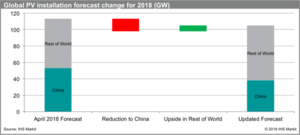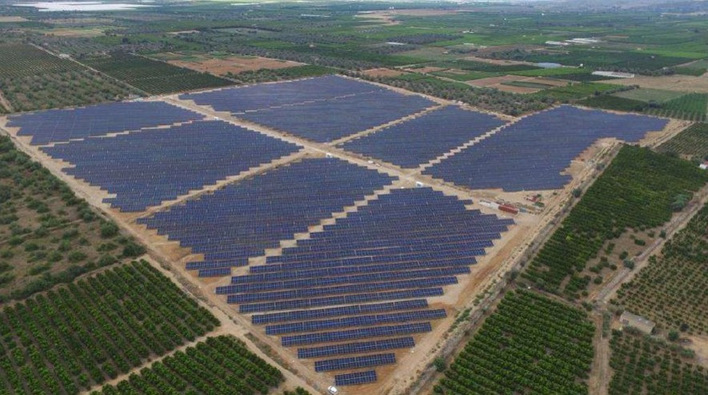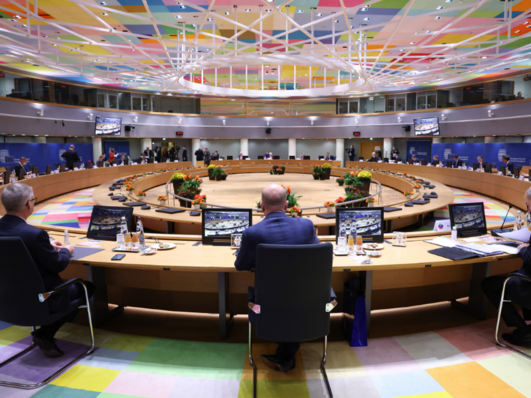„Although photovoltaic (PV) industry fundamentals remain solid, recent solar industry policy changes in China will lead to overproduction, price declines and market consolidation”, Edurne Zoco, research director for solar and energy storage, IHS Markit says. A notification has lowered the national PV feed-in tariff (FiT) for the quota of 2018. Particularly, there is no change to the FiT for PV Poverty Alleviation Power Plant. The notification also provides guidelines for various types of PV projects. The quota for 2018’s DG systems will be about 10G, while the quota for ground-mounted power plants will be suspended in 2018. Consequently, China's PV demand is estimated to drop significantly by 40% to 31.6 gigawatts compared with 2017, consultancy TrendForce specifies.
IHS Markit is a little more optimistic: its outlook for 2018 installations in China has been cut from 53 gigawatts to 38 gigawatts. Furthermore, as the majority will already have been completed in the first half of 2018, installations completed in the second half of 2018 will amount to less than half the number installed in the first half of the year. Accelerated demand across the world will still only partially compensate for the reduced outlook in China. As a result, the IHS Markit outlook for global PV installations in 2018 has fallen from 113 gigawatts to 105 gigawatts, which is still 11 percent higher than in 2017.
Hard limits on PV installations in China this year
On May 31, 2017, the Chinese government announced its “2018 Solar PV Generation Notice,” which set hard limits on PV installations in China this year. “This move will force the global solar industry to increase competitiveness and make up for falling prices, which will only make it more competitive in power markets worldwide”, Zoco says. China has grown to become the dominant country for PV technology, both in terms of installations and the manufacture of PV modules. With 50 gigawatts in 2017, China accounted for over half of all global installations. The sustainability of the market growth levels the industry has enjoyed recently have never been assured, as high levels of curtailment, severe delays in feed-in tariff (FiT) payments, a growing subsidy-budget deficit and an oversupply of electricity have cast doubt on PV demand fundamentals in China. Even so, the timing, ferocity and immediate impact of this latest policy U-turn have taken the global PV industry by surprise.

Reshape of the whole PV supply chain
„This sudden slump in China will reshape the whole PV supply chain. Supply-chain producers with a significant share of business in China will be placed under great pressure, causing a fiercely competitive environment in international markets, which will lead to aggressive price reductions across the board“, Zoco says.
With most orders on hold, and both upstream and downstream players still digesting the news and revaluating their strategies, it is premature to say when prices will finally settle. At this early stage, the concept of an “average” price is somewhat meaningless. The final price level will not only depend on China’s recent decision, but it will also be influenced by developments around the Minimum Imported Price (MIP) in Europe and India’s decisions surrounding safeguard duties and the anti-dumping investigation.
More competitive module prices expected
The fate of the global PV industry in 2018 is now somewhat sealed. The remainder of the year will be defined by overproduction and intense competition among suppliers. In order to cope with these deteriorating industry conditions, suppliers will therefore focus on keeping production lines running to generate cash, while controlling inventory levels. The price war China’s announcement has already set off will serve to reignite PV demand in regions with pent-up demand, where buyers have kept projects on hold while waiting for lower module prices. India and Australia are two markets that will benefit from more competitive module prices.
MIP price removoal in Europe will accelerate installations
European markets are waiting for a decision on the MIP in August. If the MIP is removed in Europe, the new prices will accelerate installations according to HIS Markit. In the US market, lower international prices will counteract the 201 case import duties and increase module imports. The precise outcome, in terms of volumes installed, will depend on the appetite of quickly emerging regions to procure modules in the second half of the year or bet on additional price declines. For now, many projects and orders are on hold, with developers and engineering procurement construction firms (EPCs) fully aware that the industry flipped to a buyers’ market overnight.
The next round of competitveness
The bigger questions now surround the outlook for the next two to three years. The global solar industry is now forced to take another significant step to reduce production costs, after a period of relative stability. The fact that solar is becoming increasingly competitive in power markets worldwide perhaps offers some light at the end of what is currently a rather dark tunnel for the PV industry. Solar power is already the cheapest source of electricity in some countries, and it’s also the largest energy source, in terms of capacity net-additions, for the last two years, „Once these lower prices are settled, and the industry has gone through another wave of oversupply, low profitability and consolidation, solar energy will become even more competitive across new markets”, Zoco says. (HCN)
Stay informed, get our free newslettter twice a week. Register here
More useful information:
http://www.pveurope.eu/News/Markets-Money/Further-falling-inverter-prices-market-value-declining
http://www.pveurope.eu/News/Markets-Money/90-GW-residential-solar-by-2021
https://www.pveurope.eu/solar-modules/jinko-solar-top-pv-module-shipment-provider







